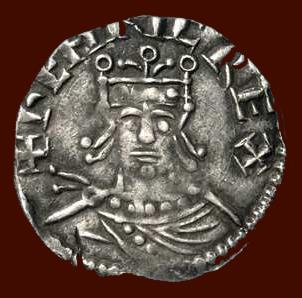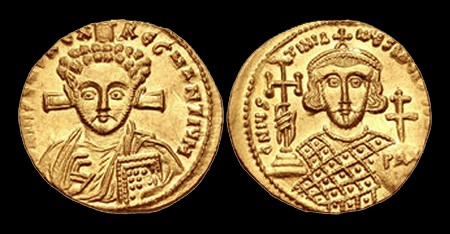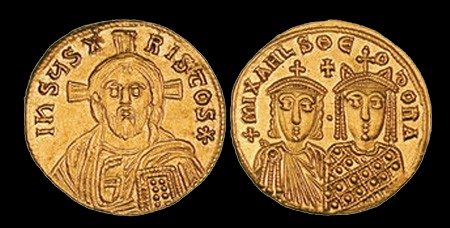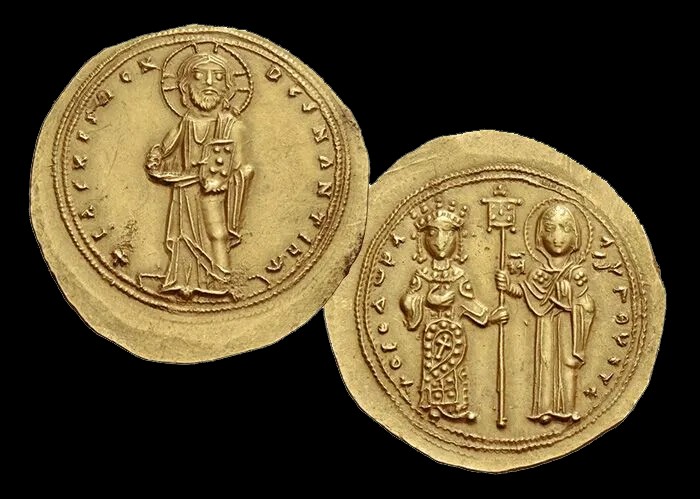




Designed by Nigel G Wilcox


The Paragon Of Metal Detecting
& Archaeology
& Archaeology
Powered By Sispro1
Coins Depicting Jesus A.D. - Currency
For Reference ONLY
Everything For The Detectorist
Copyright All Rights Reserved by Nigel G Wilcox E-Mail: ngwilcox100@gmail.com
Viking Menu
Viking Timeline
Anglo-Saxon Timeline
NormanTimeline
Pages
Main Coin Menu

Norman Menu
Member NCMD
N. Menu
Information Data
Justinian II, Part 2

Justinian II. Second reign, 705-711. AV Solidus
Overthrown in a palace coup in 695, Justinian’s nose was mutilated and he was exiled to a remote outpost in the Crimea. Mutilation was considered more humane than execution since it supposedly rendered the victim permanently ineligible for the throne. In exile, Justinian has his nose repaired by an itinerant surgeon, formed an alliance with the pagan Bulgars, married a princess of the pagan Khazars, and plotted his return to power, which he accomplished in 705. Justinian’s second reign was a reign of terror, during which he took ferocious vengeance on his opponents.
There was another dramatic change in the coinage, for reasons unknown.
There was another dramatic change in the coinage, for reasons unknown.

Justinian II, second reign (705-11 CE), with Tiberius. AV solidus.
A new portrait of Christ, with short curly hair and a short beard appeared on the obverse[8]. This “Syrian” image was said to derive from a portrait painted from life by the apostle Luke. The reverse bears Justinian’s face (with a perfectly normal-looking nose) and a new Latin inscription: “Justinian, Many Years”. Shortly afterward, Justinian added the image of his young son Tiberius to the reverse; between them they hold a cross[9]. Both types of Justinian’s second reign solidus are scarce, but being in less demand they are somewhat more affordable. On Berk’s list of the 100 greatest ancient coins, this is #93 (Berk, 115).
Overthrown by a military coup on November 4, 711, Justinian and his son were executed. The coinage returned to the conventional cross-on-steps reverse for over a century, during the period of the “Iconoclast Controversy”.
Overthrown by a military coup on November 4, 711, Justinian and his son were executed. The coinage returned to the conventional cross-on-steps reverse for over a century, during the period of the “Iconoclast Controversy”.
Theodora to Theodora

Michael III & Theodora (842-56 CE). Gold solidus (4.35 gm)
When the last Iconoclast ruler, Theophilus, died (January 20, 842) his widow Theodora restored the image of Christ to the coinage. Coins issued in her name as regent for her son Michael III are extremely rare, but they bear the image of Christ Pantocrator, closely copied from the solidus of Justinian II’s first reign but inscribed in Greek (the use of Latin had gradually died out at Constantinople). After Theodora was deposed, the coins of Michael III continued the same obverse design
Basil I “the Macedonian” came to the throne in 867 by murdering his friend and benefactor Michael III (politics was a rough game in Constantinople). On his common gold coinage, Basil placed an image of Christ enthroned, with the familiar “Rex Regnantium” inscription. This may copy a mosaic above the throne in the imperial palace, restored after it was plastered over by the Iconoclasts. Composed of simple geometric forms, the crude image is remarkably awkward, even for this era of sharply declining artistic standards. For the next two centuries, variations on this image would alternate with the haloed head of Christ as the standard obverse on Byzantine coinage.

Basil I the Macedonian, with Constantine. 867-86. AV Solidus
Theodora, the last survivor of the Macedonian dynasty founded by Basil I, ruled briefly in her own name from January 1055 to her death in August 1056. The beautifully executed coinage of this reign introduced a full length standing figure of Christ. This image may be the icon called Christ Chalkites, which stood above the main entrance of the imperial palace. On the reverse, the empress stands beside the Virgin Mary.
A very different image of a beardless youthful Christ, holding a scroll and raising His right hand in benediction, was introduced on the gold hyperpyron of Manuel Komnenos, who ruled 1143-1180. The inscription is an abbreviated Greek invocation to the Virgin for help. Some observers have noticed a striking similarity between this icon, known as Christ Emmanuel, and depictions of the Buddha.
A very different image of a beardless youthful Christ, holding a scroll and raising His right hand in benediction, was introduced on the gold hyperpyron of Manuel Komnenos, who ruled 1143-1180. The inscription is an abbreviated Greek invocation to the Virgin for help. Some observers have noticed a striking similarity between this icon, known as Christ Emmanuel, and depictions of the Buddha.
Constantinople Regained… and Lost

In 1261, Michael VIII Palaeologos recaptured Constantinople from the “Latins”, who had held it since 1204. On the reverse of his gold hyperpyron, there is a complex scene of the emperor kneeling before the standing figure of Christ, while his namesake, the Archangel Michael, hovers in the background. Most surviving examples of this type are poorly struck, from badly worn dies and with deep edge cracks. An exceptional example brought $4,750 in a recent auction
Theodora, 1055–56. Histamenon 1055-56, AV 4.43 g
The last coinage in the name of a Roman emperor was struck during the final siege of Constantinople in 1453. The obverse image of Christ is reduced to a few tentative strokes and dots, scarcely recognizable as a face.
The cataloguer writes:
…[T]the present coin is illustrative of how far the empire had fallen. Its fabric is crude, struck on recycled silver from church altar vessels in order to pay mercenaries, and the quality of the artistry no better than the worst barbaric imitative issues of the migration period, yet the historical importance of these extremely rare coins cannot be overstated.
…[T]the present coin is illustrative of how far the empire had fallen. Its fabric is crude, struck on recycled silver from church altar vessels in order to pay mercenaries, and the quality of the artistry no better than the worst barbaric imitative issues of the migration period, yet the historical importance of these extremely rare coins cannot be overstated.
Beginning in the 13th century, the rising Italian commercial powers of Florence and Venice introduced a gold coinage that would become the standard of world trade for centuries. The Venetian silver grosso bore an image of Christ enthroned, closely copied from Byzantine iconography. The gold ducato of Venice, which retained the same design down to the end of the Venetian republic in 1797, bore the standing figure of Christ (remarkably similar to that on Theodora’s coin of 1056) in an almond-shaped frame (mandorla) filled with stars
Courtesy: Featured in CoinWeek, Mike Markowitz
March 29, 2024
March 29, 2024





















